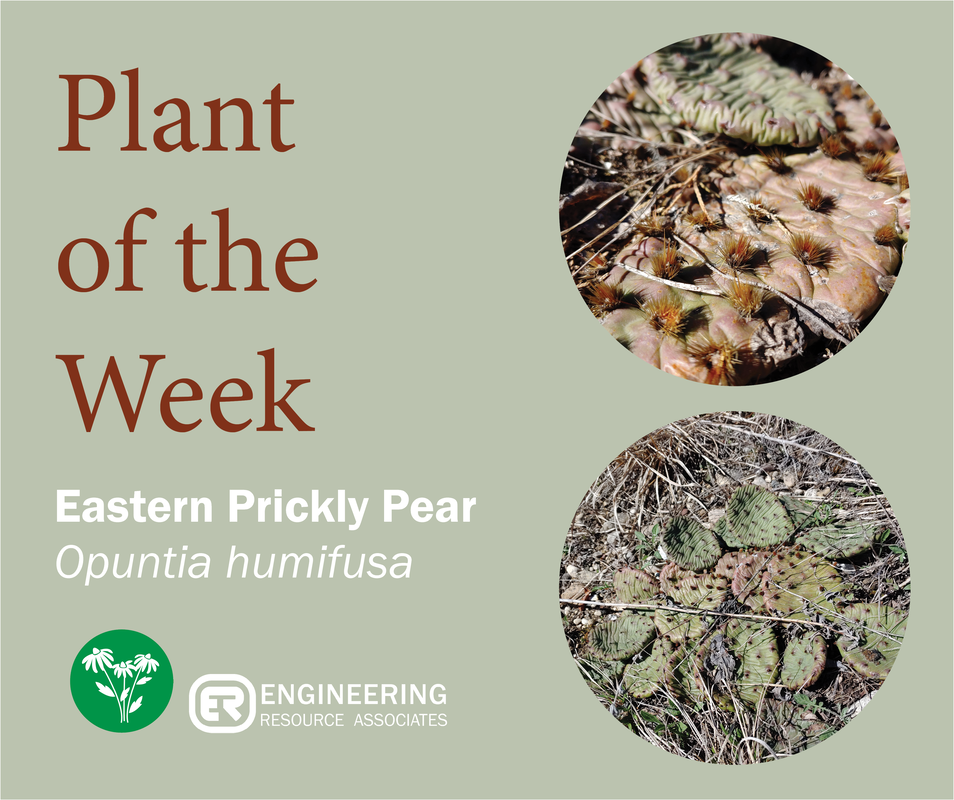This week’s plant of the week will be a summer throwback as we descend into the chill of winter: the Eastern Prickly Pear, or Opuntia humifusa! This plant is one of two native cactuses found in Illinois, the other being Opuntia fragilis, a much less common species in our state.
The Eastern Prickly Pear is found in many counties of Illinois and is generally associated with rocky/gravelly/sandy areas where the soil is well-draining, and sunlight is plentiful. The plant has a unique growth pattern consisting of ‘pads’ that grow out of the previous year’s growth and can be erect or sprawling in habit depending on site conditions. The pads are not leaves but resemble a stem as on each pad there are points of growth called areoles, from where tiny vestigial leaves emerge, surrounded by short fibrous glochids (“vestigial” refers to a non-functional organ that remains despite not being evolutionarily useful, like a human appendix or wings on an ostrich). These glochids can be quite irritating to any passers-by who unknowingly brush past this plant and serve to deter any would-be herbivores. While the plant does its best to prevent herbivores from eating the juicy pads, some animals such as coyotes, skunks, squirrels, deer, and turtles, are all known to browse this plant while foraging. The large flowers also host a wide variety of pollinators as the flower is large and pollen and nectar are plentiful.
The Eastern Prickly Pear is a vastly underused plant in native landscaping. It grows under some of the harshest conditions and can thrive in the most dry, hot, and gravelly areas where many other landscape plants would struggle to survive without the use of soil amendments or artificial irrigation. Looking past the potential gardening hazard of the glochids, this plant would make a great addition to landscaping with its incredible blooms of large yellow flowers, choice edible fruits, and interesting shapes of the mature pads that can turn shades of purple in bright direct sun. It is easiest to plant as a pad cutting, as roots will quickly take hold and germination of seed can be difficult.
While we grasp to these last few days of sunlight and warmth, think about the Eastern Prickly Pear drying out, shriveling, and browning through the harsh winter, hiding under the snow. If this rugged and fascinating plant can push through to the next summer, so can we!
The Eastern Prickly Pear is found in many counties of Illinois and is generally associated with rocky/gravelly/sandy areas where the soil is well-draining, and sunlight is plentiful. The plant has a unique growth pattern consisting of ‘pads’ that grow out of the previous year’s growth and can be erect or sprawling in habit depending on site conditions. The pads are not leaves but resemble a stem as on each pad there are points of growth called areoles, from where tiny vestigial leaves emerge, surrounded by short fibrous glochids (“vestigial” refers to a non-functional organ that remains despite not being evolutionarily useful, like a human appendix or wings on an ostrich). These glochids can be quite irritating to any passers-by who unknowingly brush past this plant and serve to deter any would-be herbivores. While the plant does its best to prevent herbivores from eating the juicy pads, some animals such as coyotes, skunks, squirrels, deer, and turtles, are all known to browse this plant while foraging. The large flowers also host a wide variety of pollinators as the flower is large and pollen and nectar are plentiful.
The Eastern Prickly Pear is a vastly underused plant in native landscaping. It grows under some of the harshest conditions and can thrive in the most dry, hot, and gravelly areas where many other landscape plants would struggle to survive without the use of soil amendments or artificial irrigation. Looking past the potential gardening hazard of the glochids, this plant would make a great addition to landscaping with its incredible blooms of large yellow flowers, choice edible fruits, and interesting shapes of the mature pads that can turn shades of purple in bright direct sun. It is easiest to plant as a pad cutting, as roots will quickly take hold and germination of seed can be difficult.
While we grasp to these last few days of sunlight and warmth, think about the Eastern Prickly Pear drying out, shriveling, and browning through the harsh winter, hiding under the snow. If this rugged and fascinating plant can push through to the next summer, so can we!

